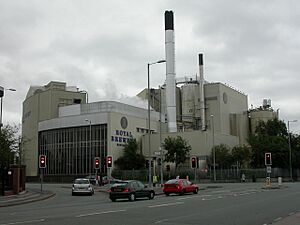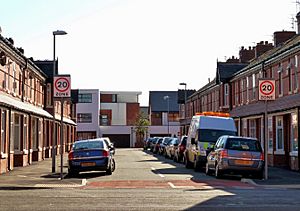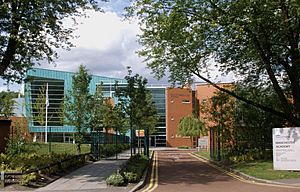Moss Side facts for kids
Quick facts for kids Moss Side |
|
|---|---|
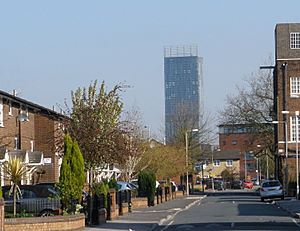 Alexandra Park Estate in Moss Side, looking towards the Beetham Tower |
|
| Population | 20,745 (2021) |
| OS grid reference | SJ835955 |
| • London | 162 mi (261 km) SE |
| Metropolitan borough | |
| Metropolitan county | |
| Region | |
| Country | England |
| Sovereign state | United Kingdom |
| Post town | MANCHESTER |
| Postcode district | M14, M16 |
| Dialling code | 0161 |
| Police | Greater Manchester |
| Fire | Greater Manchester |
| Ambulance | North West |
| EU Parliament | North West England |
| UK Parliament |
|
| Councillors |
|
Moss Side is a lively area in Manchester, England. It's about 3 kilometers (1.9 miles) south of the city centre. In 2021, around 20,745 people lived here. Moss Side is surrounded by other areas like Hulme to the north and Whalley Range to the south.
You can find Whitworth Park and Alexandra Park nearby. Moss Side is also close to the University of Manchester and Manchester Metropolitan University. For many years, the famous football team Manchester City F.C. played at their home stadium, Maine Road, right here in Moss Side, from 1923 to 2003.
Contents
A Look Back at Moss Side's Past
Moss Side was once a quiet, countryside area. It was part of Lancashire, a historic county in England. People think its name comes from a large marshy area called a "moss." The first time Moss Side was mentioned was in 1533.
Back then, it was described as a beautiful rural place with a clear pool and an old farmhouse. But after the Industrial Revolution, things changed quickly. Many people moved to the area, and it became a busy, crowded place. The population grew from just 151 people in 1801 to over 26,000 by 1901! Because of this growth, parts of Moss Side became part of the city of Manchester in 1885 and 1904.
In the late 1800s and early 1900s, many red brick houses were built. These homes attracted lots of new residents, including immigrants from Ireland.
Manchester City F.C. moved to their new stadium on Maine Road in Moss Side in 1923. It was one of the biggest sports stadiums in the UK at the time, holding up to 85,000 fans! The team played there for 80 years.
During World War II, some houses in Moss Side were damaged by bombings. In the 1950s and 1960s, many people from the Indian subcontinent and the Caribbean came to live in Moss Side. By the 1980s, it was a main centre for Manchester's Afro-Caribbean community.
In the 1960s and 1970s, many older houses were replaced with new council homes and flats. Later, in the 1990s, some of these newer buildings were updated. Moss Side has faced challenges over the years, but local police and community groups have worked hard to make the area safer and better for everyone.
How Moss Side is Governed
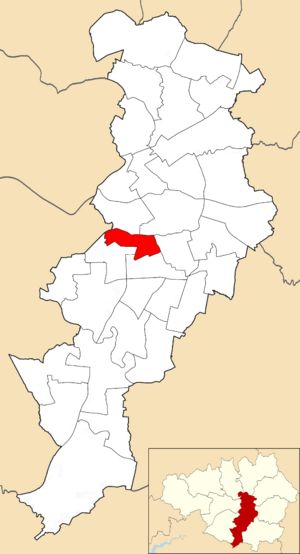
Most of Moss Side is part of the Manchester Central area for the UK Parliament. This area is represented by Lucy Powell, a Member of Parliament (MP) from the Labour Party. A smaller part of Moss Side is in the Manchester Gorton area, represented by Labour MP Afzal Khan.
Moss Side is also a "ward" within the local government, which is the Manchester City Council. The ward is represented by three Labour Councillors: Mahadi Hussein Sharif Mahamed, Emily Rowles, and Erinma Bell. These councillors help make decisions for the local community.
Exploring Moss Side's Geography
Moss Side is located around the A5103 (Princess Road). This is a major road that leads out of Manchester towards the airport and other towns. Another important road is Alexandra Road, which goes past Alexandra Park.
You can spot the Royal Brewery and the Princess Road Bus Depot along Princess Road. The bus depot was first built in 1909 for trams!
Moss Side has a lot of homes, mostly older Victorian and Edwardian style houses in the east and centre. There are also newer homes, like those in the Alexandra Park Estate, built in the 1970s.
The Moss Side Sports and Leisure Complex was improved for the 2002 Commonwealth Games. It has a gym and many other sports facilities for the community.
 |
Old Trafford | Hulme | Chorlton-on-Medlock |  |
| Old Trafford Whalley Range |
Rusholme | |||
| Whalley Range | Whalley Range Fallowfield |
Fallowfield |
New Life and Improvements in Moss Side
Since the mid-1990s, Moss Side has seen many big changes and improvements. Old houses have been updated, and new homes have been built.
For example, a large area on Great Western Street now has new 2, 3, and 4-bedroom homes. Some are for rent, and others can be bought.
The old Manchester City F.C. Maine Road stadium site has been completely redeveloped. It's now called Maine Place and has new houses and flats. There's also a primary school and a health centre planned for the site.
Another area, Bowes Street, has also been redeveloped. Over 150 properties were renovated or built. These new homes are very eco-friendly, with solar panels and special insulation to save energy. The goal is to offer modern, energy-efficient homes and make Moss Side a great place to live.
Even empty spaces, like the former bus depot, are being used for community projects. Local groups are turning it into an apple orchard! These changes are helping to improve how people see Moss Side.
Industries in Moss Side
Brewing History
Moss Side has a long history of making beer, going back to the 1800s.
The Royal Brewery has been around since 1875. It used to be called the Albert Brewery. The water there was known for being very good for brewing. Today, it's owned by Heineken and makes Foster's Lager.
Another famous brewery, Hydes Brewery, was built on Moss Lane West in 1861. It was known as the Queen's Brewery before Hydes took it over in 1898. Beer was made there until 2012. The old brewery building is now a protected historical site.
A cool local project is the Moss Cider Project. It started in 2010. Volunteers collect apples from trees in Moss Side and the surrounding areas. They then turn these apples into cider and apple juice. People who donate apples get some of the finished product!
Other Local Businesses
Moss Side is home to other businesses too. Aquatech Pressmain, a company that provides pumping equipment, has an office here.
Bridgewater Hospital, a private hospital on Princess Road, offers various healthcare services.
Who Lives in Moss Side?
Moss Side has a very diverse population. For a long time, it has been home to people from the Caribbean and South Asia. More recently, people from places like Somalia and Eastern Europe have also moved to the area.
This mix of cultures makes Moss Side a vibrant community. The population has been growing steadily, with more young families moving in.
Community Life in Moss Side
Moss Side is full of community groups that offer support and fun activities. For the Afro-Caribbean community, there's The West Indian Sports and Social Club and the African and Caribbean Mental Health Service. The exciting Caribbean Carnival of Manchester is held in Alexandra Park every August.
The Indian Senior Citizens group helps older people in the Indian community. There are also groups for the Somali and Polish communities, like the Somali Bravanese Sisters and the Polish School Manchester.
The Reno was a famous late-night club in Moss Side. It was a very important place for Manchester's West Indian community and helped shape black culture in the city.
Many people in Moss Side are interested in green politics and sustainable living. The Moss Cider Project is a great example of this. The Moss Side Community Allotment lets volunteers grow organic food. There's also a "meanwhile garden" on the old bus depot site that's becoming an apple orchard. These projects help make the area greener and bring people together.
The Millennium Powerhouse is a youth service for young people aged 8 to 25. It has a music studio, dance studio, sports hall, and offers advice and activities. The Windrush Millennium Centre provides adult education and other community facilities. You can also find many Polish, Indian, and Somali cafes and restaurants in Moss Side.
Learning and Education
In 2003, Ducie Central High School was replaced by Manchester Academy. This new school aimed to help young people in the community succeed in their education. The Academy has been very successful! By 2010, 81% of its students achieved good grades (A*–C) in their GCSE exams, which was a huge improvement. The Academy has won awards for its partnerships and its students have even been national debating finalists.
Moss Side has five primary schools:
- Claremont Primary School
- Devine Mercy RC Primary School
- Holy Name RC Primary School
- St Mary's CE Junior and Infant School
- Webster Primary School
In 2014, St Mary's CE Junior and Infant School won a national award for Primary School of the Year!
For older students and adults, the Windrush Millennium Centre and the Greenheys Adult Learning Centre offer various courses and adult education programs.
Places of Worship
Moss Side has several churches. The original St James's Church (Church of England) was built in 1887. It has since been replaced by a modern building that also serves as offices for community groups.
Christ Church, built in 1899–1904, is an Anglican church and a protected historic building.
There are also two Roman Catholic churches: the Church of Divine Mercy, a Polish church founded in 1961, and the Church of Our Lady, founded in 1949. The Polish church is in an old Methodist chapel and has beautiful stained glass windows.
-
Good Friday walk crossing Princess Road
Sports in Moss Side
From 1923, Moss Side was famous for being the home of Manchester City F.C.'s stadium, Maine Road. In its early days, the stadium could hold over 80,000 fans! Over time, its capacity changed. By the mid-1990s, it held just under 35,000 seated spectators.
Manchester City eventually moved to a new stadium, the City of Manchester Stadium. Maine Road was then taken down, and the site has been redeveloped into new homes and a primary school.
Famous Faces from Moss Side
Many interesting people have connections to Moss Side:
- Emmeline Pankhurst, a famous political activist and leader for women's voting rights, was born here.
- The author Anthony Burgess lived in Moss Side as a child.
- The historian Michael Wood also grew up in Moss Side.
- Frederick Engels, a well-known philosopher, lived in Moss Side for a time and wrote about the lives of working people.
- George Garrett, a clergyman and inventor of submarines, was a vicar in Moss Side.
- The novelist Bertha Jane Grundy was born in Moss Side in 1837.
- Kath Locke, a community activist, helped start the Abasindi Co-operative. The Kath Locke Centre in Moss Side is named after her.
- Philomena Lynott, the mother of Thin Lizzy frontman Phil Lynott, lived in Moss Side with her son because it was a welcoming place for single mothers with mixed-race children.
- The DJ "A Guy Called Gerald" (Gerald Simpson) grew up in Moss Side.
- British musician and composer Barry Adamson was born in Moss Side. His album Moss Side Story is even named after the area!



